Archive for November, 2009
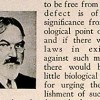
Hybrid Vigor in Corn and People
Nov 30th
The recent completion of the maize (corn) genome sequence gives us pause to think about the historical connection between agriculture and eugenics. It also causes us to consider why the leading American eugenicist, Charles Davenport, failed take greater stock in the corn research going on at one of several institutions he presided over at Cold Spring Harbor.
Especially in the United States, eugenics was firmly grounded in agriculture. Many of the leaders of the American movement had backgrounds in plant and animal breeding. For example, prior to becoming superintendent of the Eugenics Record Office (ERO) at Cold Spring Harbor, Harry Laughlin had More >

Autism and Marijuana
Nov 30th
This morning, “Good Morning America,” a popular morning news program in the U.S. told the story of a mother with an autistic child who was “treating” him with marijuana. I use quotation marks, and will make other cautionary notes here, because this blog is not meant to represent any forum of medical advice.
At the time of writing this, the GMA website, which usually posts follow-ups, has nothing on their site, which I found a little strange. The mother also appeared not with another member of her family, but a lawyer, who was also a family friend. I wondered how these More >

Six Tips on Avoiding Cancer
Nov 30th
Most of us know that smoking cigarettes and excess exposure to the sun can increase the risk of getting cancer. In fact, much of cancer can be avoided by changing behavior. For examples of some causes of cancer, check out Inside Cancer. Some of the causes of cancer are less obvious. An example is maintaining a healthy weight. Did you know that overweight people are 50% more likely to die of cancer than those with normal body weight? In the United States, this means each year about 90,000 people die of cancer that could be prevented if we could all More >
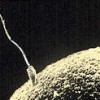
Some Cells Have 23 Chromosomes
Nov 25th
It is a game of chance! With one spin of a wheel, X and Y chromosomes, represented by pink (X) and green ping-pong balls (Y), are passed from each parent to a child. When the wheel stops, the baby is either a boy or a girl – depending on which chromosomes were inherited. It is a simple, yet powerful tool that demonstrates basic chromosomal inheritance. It is easy to see that every time the wheel is spun, there is a 50/50 chance of having a boy or a girl.
Demonstrations with this wheel have led to some very interesting student responses and questions. I have More >

Forensics in the classroom
Nov 23rd
It is important as teachers to incorporate subject matter that is of interest to your students. This will get them more excited about the process of learning. Recently, I have seen an ever growing interest in forensic science, with the help of the media. This offers valuable teaching opportunities. Almost every student that I have encountered has seen at least one episode of CSI or Law & Order.
So how can you take this material from the television screen into the classroom? Using the applications of DNA testing alone can provide you with a wide range of lessons, including the use of DNA More >
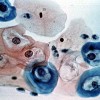
HPV twist?
Nov 17th
Human Papilloma Virus (HPV) is a family of small, non-enveloped DNA viruses which infect epithelial cells, and of which there are over 100 subtypes. HPV is divided into two major categories, high risk types which includes types 16, 18, 31. 33, 35. 39, 45, and low risk types 6 and 11. HPV 16 is implicated in over 90% of cervical cancers and shown to be a causal factor in the development of the disease. HPV produces two oncoproteins, E6 and E7, which inactivate the cellular tumor suppressor proteins, p53 and pRB respectively. This allows it to disable two of the More >
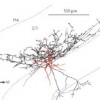
Your teacher was wrong!
Nov 12th
I studied neuroscience in college and subsequently taught it for three years at university. One of the central tenants of the course I studied and taught was the dogma of synaptic transmission. The basic tenant of this dogma is that neurons communicate exclusively by sending chemical signals across the synaptic cleft. Pretty much every neuroscience textbook ever written is filled with this idea. It turns out that this is not actually the whole truth. To communicate, brain cells do not need a synapse at all!
This is the surprising news from a team of researchers are the University of Szeged, Hungary. More >
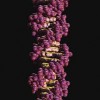
Does New DNA Always Mean New Traits?
Nov 10th
I was teaching a class of fifth grade students last week and we were discussing the characteristics of DNA and cells. As a group, we described how the human body is made up of a variety of cell types, including muscle cells, nerve cells, and more. I explained that although cells can be diverse in their appearance and functions, within one organism they all have the same DNA (except for mature red blood cells and gametes). The reason that a nerve cell is different from a bone cell is simply that they use different recipes in different ways.
A student then More >

The new "oldest" member to our hominid family tree
Nov 9th
During an anthropological expedition in 1992 to the Middle Awash river valley in Ethiopia, a research team led by Tim White uncovered a fascinating, previously unknown fossil Hominid. In 1994, the fossil was named Ardipithecus ramidus. In the Afar language, “Ardi” means ground floor and “ramid” means root.
Affectionately known as “Ardi”, some of her features were distinctive. Due to her location in the ancient Ethiopian strata, she was dated to 4.4 million years ago, pre-dating “Lucy” (Australopithecus afarensis) by over a million years. Her brain size was much smaller than Lucy’s but was similar to that of a modern chimpanzee. More >

How can I prolong health? Hmmm…..
Nov 6th
Having an edge on the stock market can allow one to make hundreds, thousands or even millions of dollars. But rarely do we think of having an edge on life. Since the sequencing of the human genome our understanding of human genes and their interaction has grown. Geneticists now have the capability to analyze genetic make-ups, and elucidate what genetic patterns will evolve into certain conditions or disease states.
Any individual has a unique genetic profile different from that of another person. Contained within these differences are unique genetic variations that may make a person more susceptible to diseases such as More >
